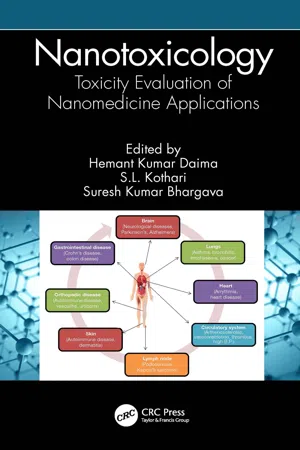
Nanotoxicology
Toxicity Evaluation of Nanomedicine Applications
- 480 pages
- English
- ePUB (mobile friendly)
- Available on iOS & Android
Nanotoxicology
Toxicity Evaluation of Nanomedicine Applications
About this book
The field of nanomedicine has risen quickly due to the increasing number of designer-made nanomaterials. These nanomaterials have the potential to manage diseases and change the way medicine is currently studied. However, the increased practice of using nanomaterials has shed light on how many concepts of nanomedicine and nanotoxicity have been overlooked. Nanotoxicology: Toxicity Evaluation of Nanomedicine Applications addresses the existing gaps between nanomedicine and nanotoxicity. This book also brings together up-to-date knowledge on advances toward safe-by-design nanomaterials and existing toxicity challenges.
This book delivers a comprehensive coverage in the field with fundamental understanding, serving as a platform to convey essential concepts of nanotoxicology and how these concepts can be employed to develop advanced nanomaterials for a range of biomedical applications. This book is an effort to answer some of the thoughtful nanotoxicological complications and their auspicious probable solutions with new approaches and careful toxicity assessment.
Key Features:
-
- Reveals novel nanoscale approaches, toxicity assessment, and biomedical applications
-
- Includes importance of nanotoxicity concepts in developing smart nanomaterials
-
- Highlights unique contributions and "A to Z" aspects on the state-of-the-art from global leaders
-
- Offers a complete package to learn fundamentals with recommendations on nanomaterials toxicity and safe-by-design nanomedicines
Nanotoxicology: Toxicity Evaluation of Nanomedicine Applications illuminates the high potential of many innovative nanomaterials, ultimately demonstrating them to be promising substitutes for available therapies that can be effectively used in fighting a myriad of biomedical complications. Further, this book reports legal, ethical, safety, and regulatory issues associated with nanomaterials, which have often been neglected, if not overlooked in literature and limiting clinical translation at nanoscale level. It will equip readers with cutting-edge knowledge of promising developments in nanomedicine and nanotoxicology, along with potential future prospects.
Frequently asked questions
- Essential is ideal for learners and professionals who enjoy exploring a wide range of subjects. Access the Essential Library with 800,000+ trusted titles and best-sellers across business, personal growth, and the humanities. Includes unlimited reading time and Standard Read Aloud voice.
- Complete: Perfect for advanced learners and researchers needing full, unrestricted access. Unlock 1.4M+ books across hundreds of subjects, including academic and specialized titles. The Complete Plan also includes advanced features like Premium Read Aloud and Research Assistant.
Please note we cannot support devices running on iOS 13 and Android 7 or earlier. Learn more about using the app.
Information
1 Nanomaterials
Powder Metallurgy & New Materials (ARCI)
1.1 Introduction to Nanomaterials


1.1.1 Nanoscale Size Effect
1.1.1.1 Surface Area and Surface Area to Volume Ratio
Table of contents
- Cover
- Half Title
- Title Page
- Copyright Page
- Dedication
- Table of Contents
- Preface
- Acknowledgments
- Editors
- Contributors
- Chapter 1 Nanomaterials: Types of Nanomaterials and Their Fundamental Physicochemical Properties
- Chapter 2 Innovations in Nanotechnology for Biomedical Sensing, Imaging, Drug Delivery, and Therapy
- Chapter 3 Nanomaterials for Drug Delivery
- Chapter 4 PLGA-Based Nanoparticulate Systems: New Trends in Nanomedicine
- Chapter 5 Employing New Targeted Nanoencapsulation for Alzheimer’s Disease Treatment: A Change for the Better?
- Chapter 6 Nanomaterials-Assisted Elicitation of Pharmaceutically Important Secondary Metabolites from In Vitro Plant Cell Cultures
- Chapter 7 Impact of Nanomaterials on Health and Environment
- Chapter 8 Consequences of Nanomaterials on Human Health and Ecosystem
- Chapter 9 Conceptual Understanding of the Mechanisms of Nanotoxicity and Safety of Nanomedicines
- Chapter 10 Insights into the Mechanisms of Nanotoxicity and Evaluation of Nanomaterials
- Chapter 11 Sensors to Monitor and Evaluate the Toxicity of Nanomedicine Applications
- Chapter 12 Systems Approaches for Toxicological Assessment of Nanomaterials
- Chapter 13 Measurement of Oxygen Consumption Rate Based on Fluorescence Intensity and Lifetime as a Strategy to Assess Nanotoxicity
- Chapter 14 Current Knowledge on Toxicity of Nanomaterials: Toxicity Assessment and Impact
- Chapter 15 The Role of Nanotechnology in the Management of Water Toxicity
- Chapter 16 Challenges in the Assessment of Nanotoxicity, Recommendations, and Safe-by-Design Nanomedicines to Counter Toxicological Problems
- Chapter 17 Current Guidelines and Regulatory Challenges, Insight into the Legal, Societal, and Ethical Issues of Nanomaterials
- Index